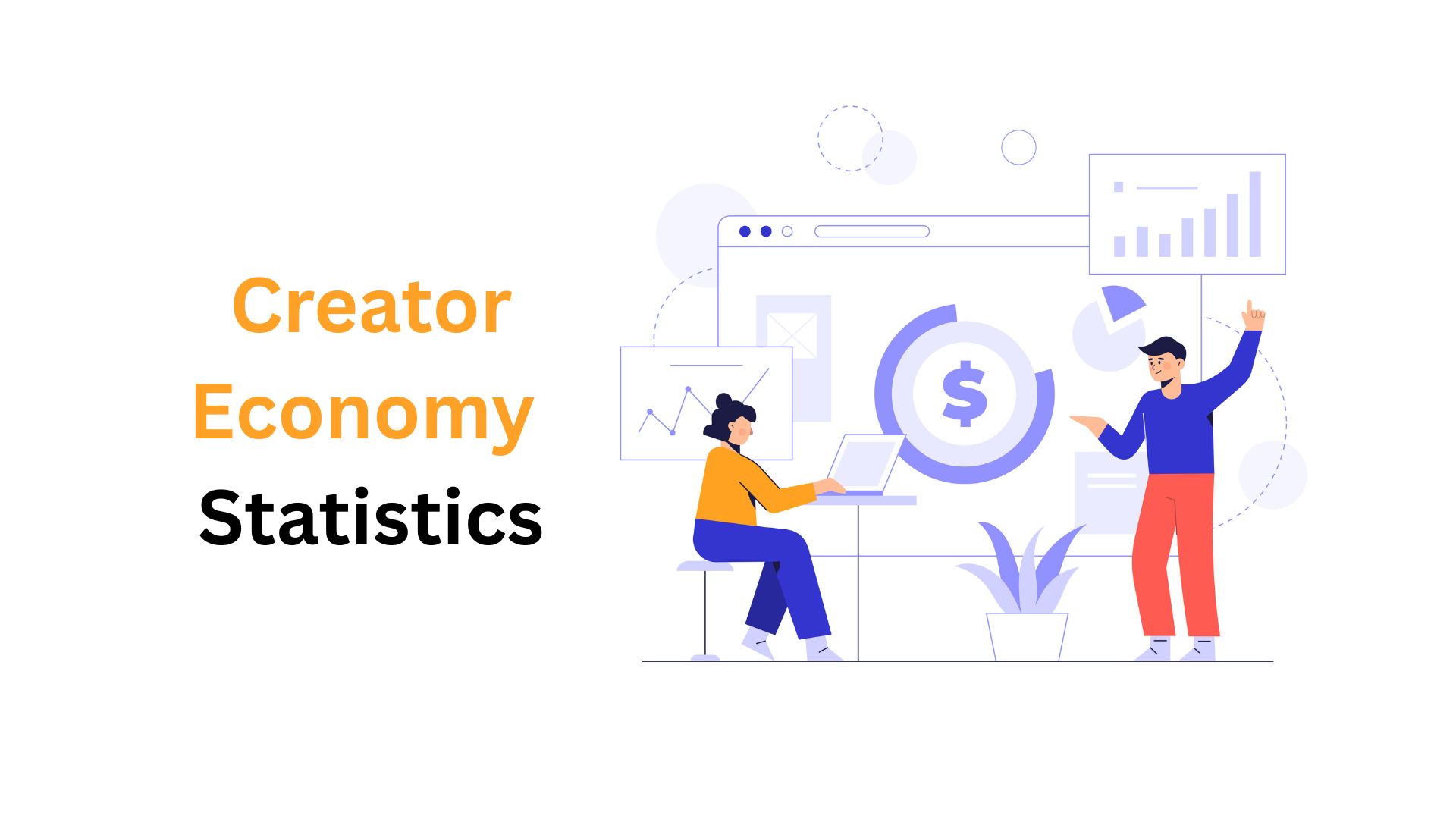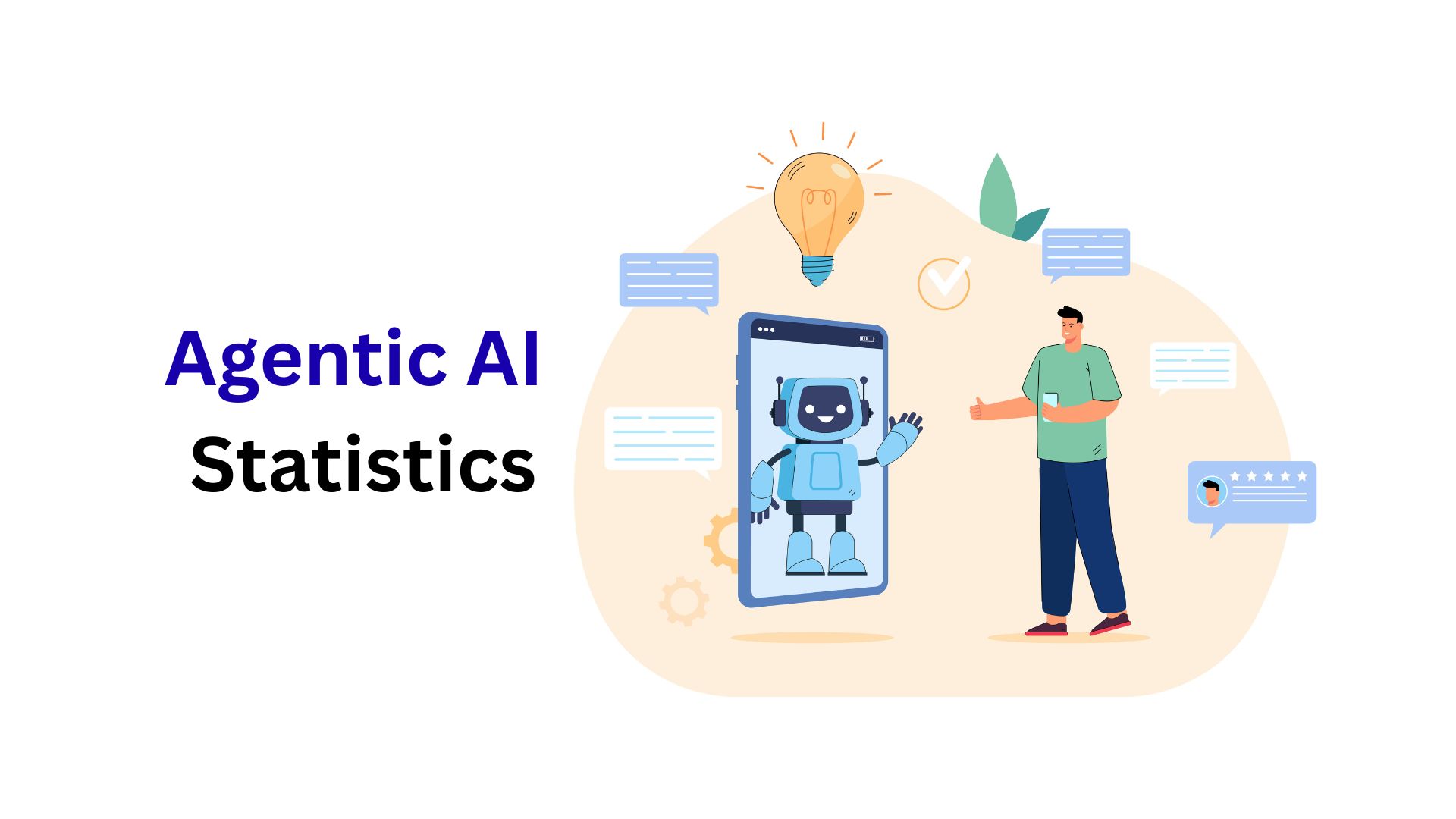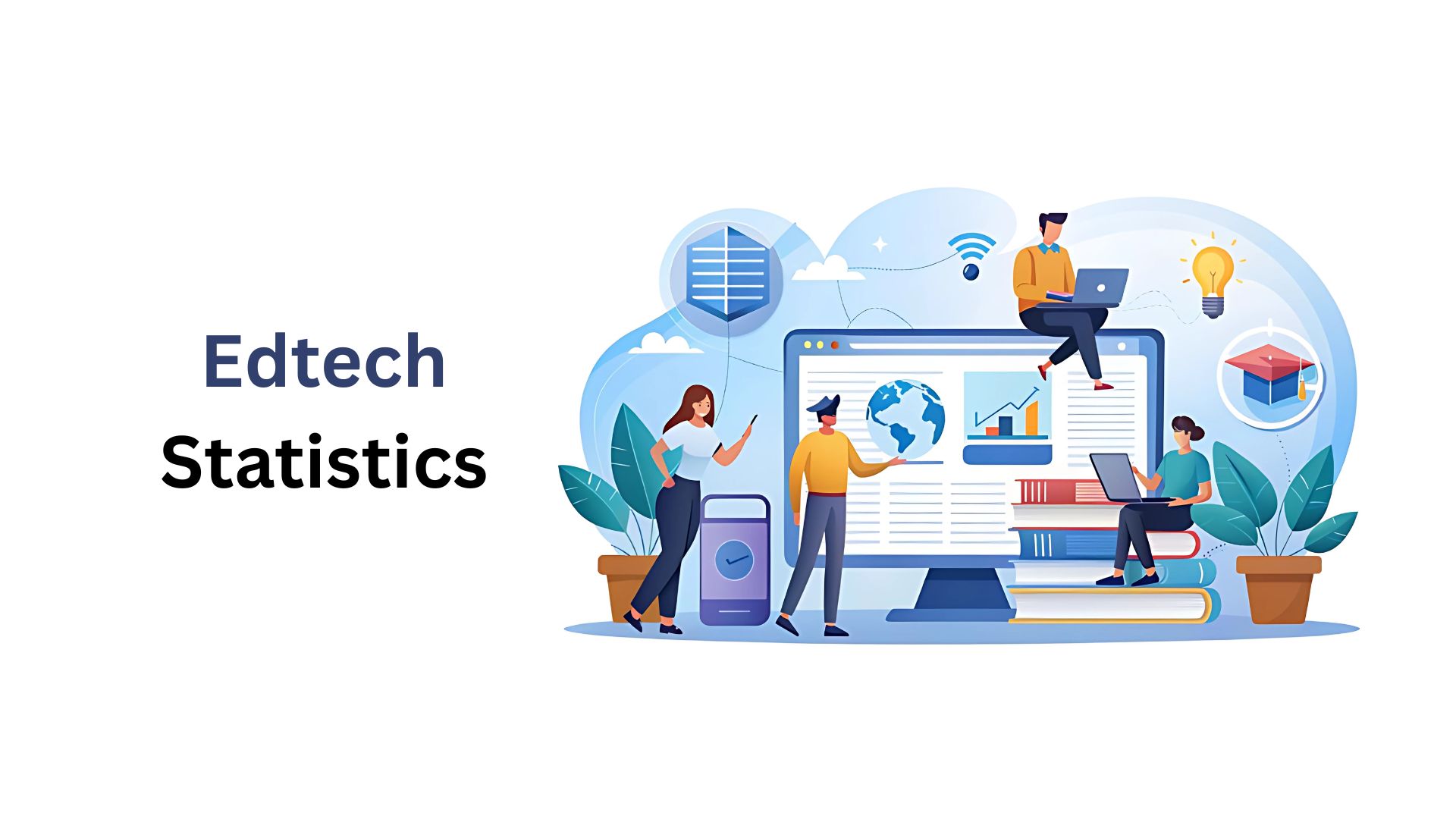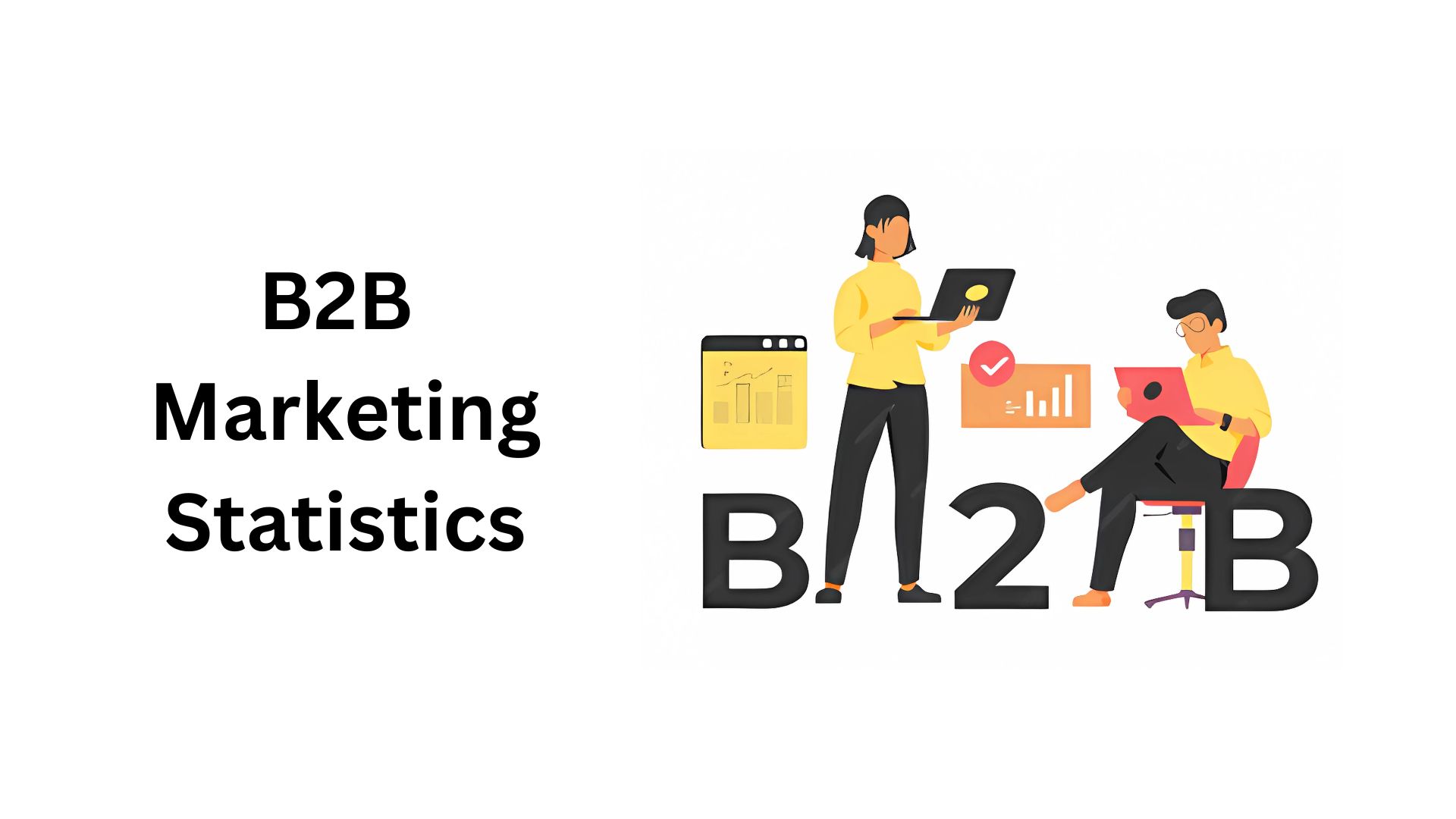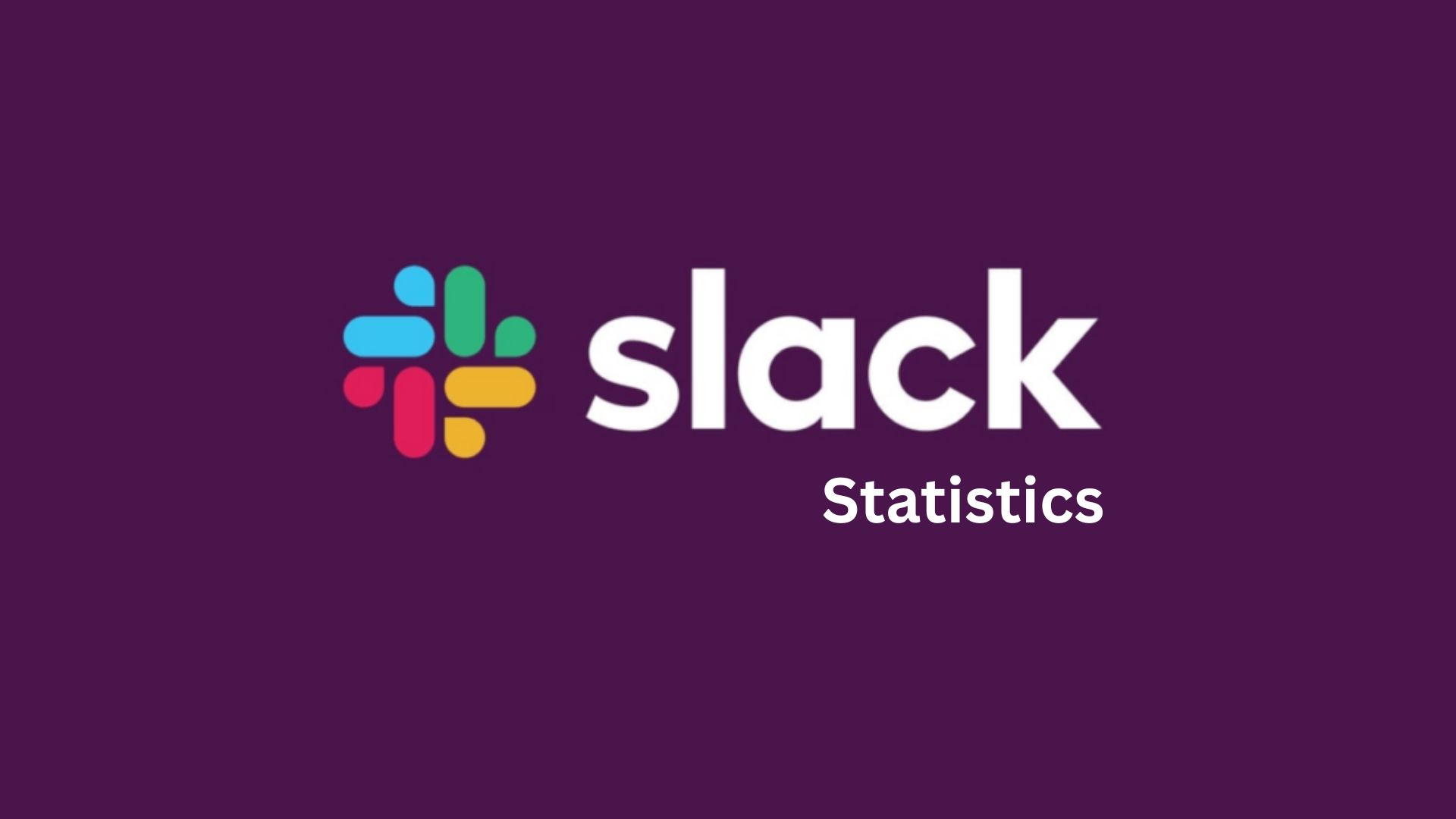Artificial Intelligence Statistics By Market, Technology, Revenue, Demographic And Facts (2025)

Updated · Jul 18, 2025

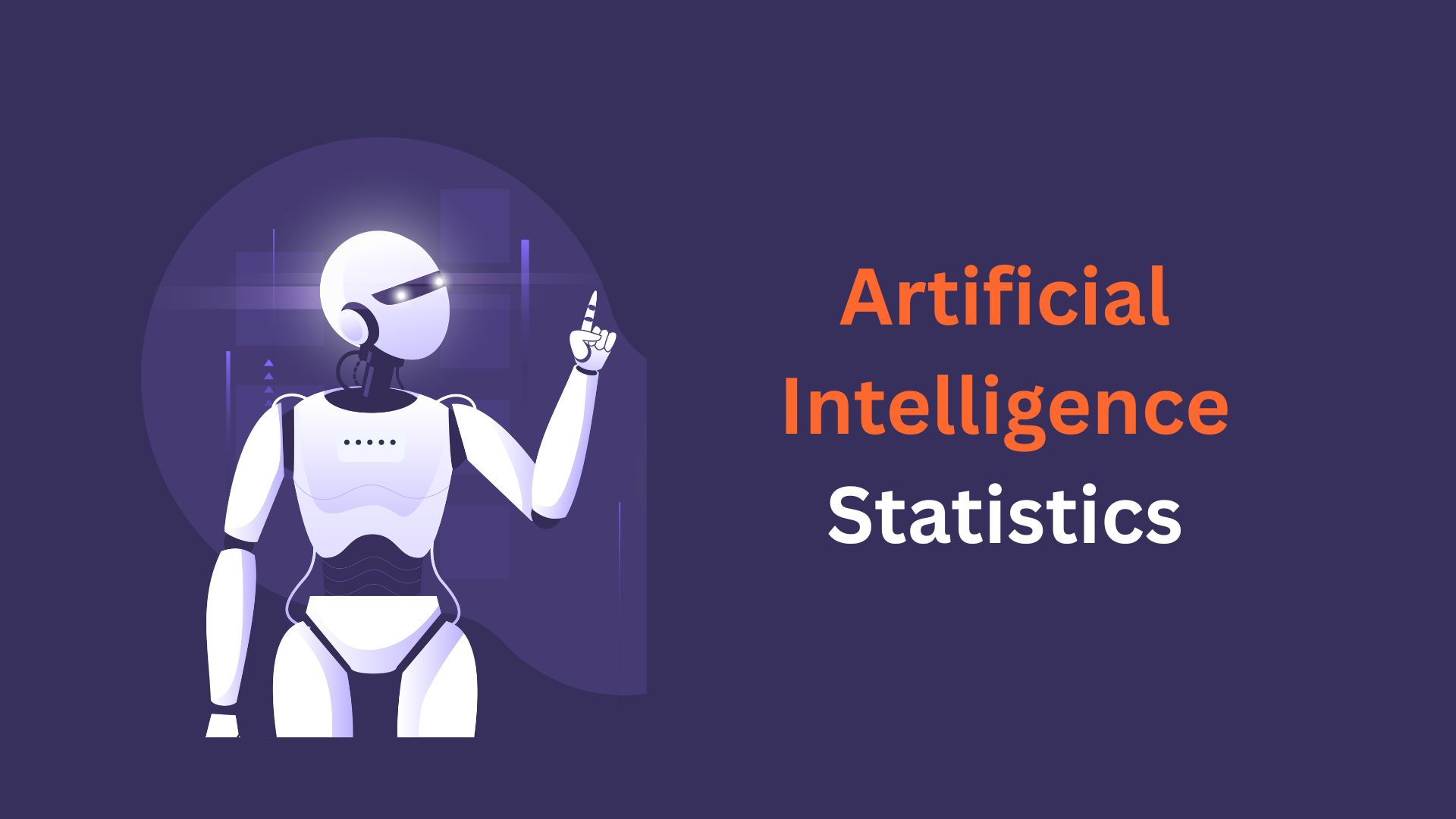
WHAT WE HAVE ON THIS PAGE
- Introduction
- Editor’s Choice
- Global AI Market Statistics
- Artificial Intelligence Market Statistics by Segments
- Artificial Intelligence Market Statistics by Country
- By Region
- By Digital Assistants
- Artificial Intelligence Technology Statistics
- Artificial Intelligence Solution Statistics
- Global Artificial Intelligence Market Revenue Statistics By Industry in 2024
- Artificial Intelligence Software Revenue Statistics
- Generative Artificial Intelligence Market Size Statistics
- Artificial Intelligence Uses Statistics
- By Workplace and Personal Use
- By Consumers
- Artificial Intelligence Demographic Statistics by Age Group
- Artificial Intelligence in Businesses Statistics
- Artificial Intelligence in Marketing Statistics
- Artificial Intelligence Job Market Statistics
- Artificial Intelligence Training Statistics
- Salaries for AI Professionals Statistics
- Addressable Artificial Intelligence Statistics by Scenario
- Artificial Intelligence Impact on the Demand Statistics by Skills
- Companies Investing in Artificial Intelligence Statistics
- Company’s Artificial Intelligence Tool Adoption Statistics
- Benefits of Artificial Intelligence Statistics
- Challenges of Investing In Artificial Intelligence Statistics
- Recent Developments of Artificial Intelligence Statistics
- Artificial Intelligence Gross Value Added Statistics by Industry in 2035
- Conclusion
Introduction
Artificial Intelligence Statistics: Artificial intelligence (AI) helps in changing the modern way of living, working, and thinking. It also allows machines or computers to do tasks that normally need human brains, such as understanding speech, solving problems, learning from data, and even making decisions. In day-to-day life, AI is now essential in almost every area, like healthcare, education, transport, and business, helping people work faster, make better decisions, and solve problems easily.
This article includes several statistical analyses from different insights that will guide you to an effective understanding of what AI is, how it works, and why it matters in today’s fast-changing world.
Editor’s Choice
- Statista report analysis states that in 2025, the global AI market will account for USD 244.22 billion and is estimated to reach USD 244.22 billion by the end of 2031.
- The annual growth rate of the market will grow at a CAGR of 26.60% from 2025 to 2031.
- In the same duration, around 97 million people are expected to work in AI.
- Nearly 83% of companies say AI is key to their plans.
- In contrast, Netflix earns USD 1 billion yearly from AI suggestions.
- Almost 50% of businesses and 38% of doctors already use AI in daily tasks.
- In July 2025, OpenAI.com got around 1.2 billion visits each month, while ChatGPT.com had over 5 billion, ranking fifth worldwide.
- Around 83% of businesses say that using AI is very important in their plans and goals.
- A report published by the Insight Partners in 2025 states that the global market revenue of artificial intelligence software is expected to reach USD 126 billion.
- This year, the wearable AI market is likely to grow and reach USD 180 billion in value, according to Global Market Insights.
- As per the reports of Search Logistics, around 97 million jobs will be needed in industries related to artificial intelligence by 2025.
- According to PwC, using AI at work could help employees get 40% more work done by 2035.
- A report published by the National University elaborates that AI could take away 85 million jobs by 2025, but also create 97 million, giving 12 million more jobs overall.
Global AI Market Statistics
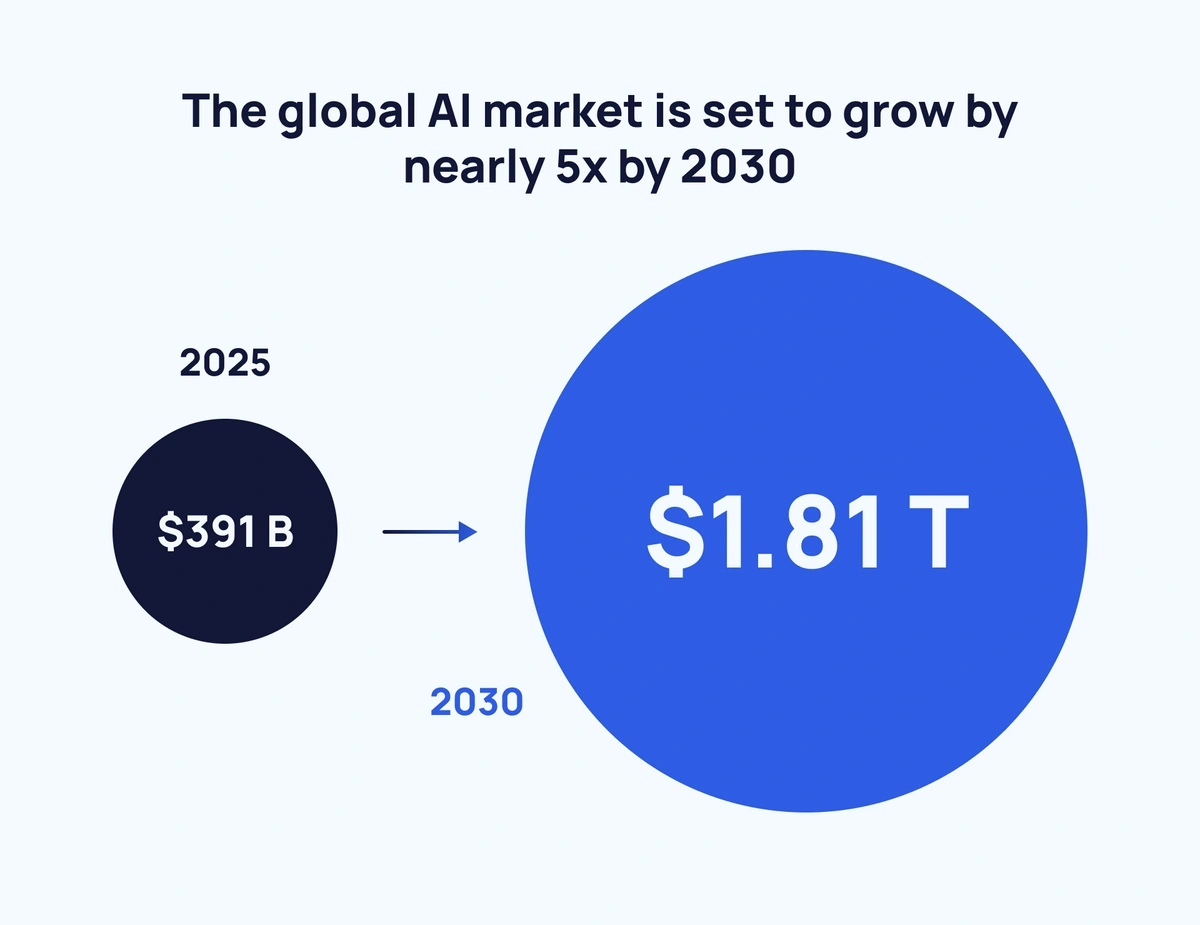
- As of 2025, the global AI market will be worth about USD 391 billion.
- By 2030, it’s expected to grow and reach nearly USD 1.81 trillion.
- The annual growth rate of the market is estimated to reach a CAGR of 35.9% from 2025 to 2030.
- This means the value of the AI industry could become five times bigger in the next five years.
- National University elaborates that about 77% of today’s devices already include some kind of AI feature.
- Nearly 9 in 10 companies use AI to stay ahead of competitors.
- Artificial Intelligence also states that by 2030, AI could add around USD 15.7 trillion to the world’s economy.
- Over the next three years, 63% of companies plan to start using AI.
- The global AI market will grow 33% in 2024 and may grow by over 120% each year.
- Meanwhile, 77% of people use AI tools, but only one-third realise it.
- Also, 88% of those not using generative AI don’t understand its impact.
Artificial Intelligence Market Statistics by Segments
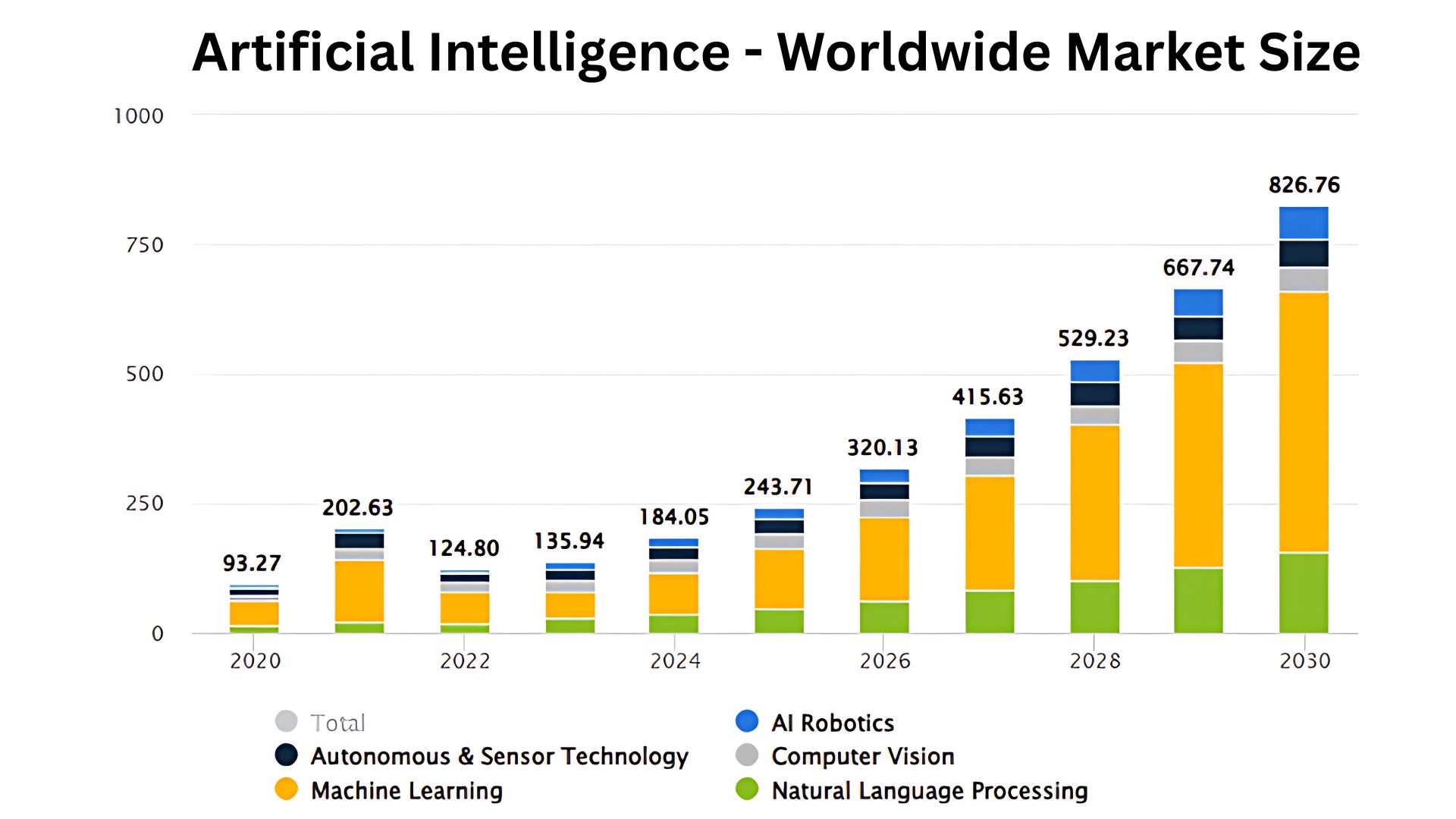
- The above graphical analysis shows that in 2025, the machine learning market will account for the highest revenue of USD 113.10 billion, with a change of 65% from last year.
- Moreover, followed by other segmental revenue and change rate are natural language processing (USD 48.31 billion) (32.65%), autonomous & sensor technology (USD 30.51 billion) (19.61%), computer vision (USD 29.27 billion) (13.48%), and AI robotics (USD 22.52 billion) (32.26%).
In the coming years, other segmental market sizes and change rates are mentioned in the table below:
| Year | Machine Learning | Natural Language Processing | Autonomous & Sensor Technology | Computer Vision | AI Robotics |
| (USD billion) | |||||
|
2026 |
159.80 (41.27%) | 63.35 (31.14%) | 35.25 (15.55%) | 32.57 (11.27%) | 29.16 (29.51%) |
| 2027 | 221.70 (38.73%) | 81.67 (28.91%) | 39.77 (12.80%) | 35.71 (9.63%) |
36.78 (26.12%) |
|
2028 |
298.70 (34.74%) | 102.80 (25.86%) | 44.07 (10.82%) | 38.70 (8.38%) | 44.96 (22.25%) |
| 2029 | 394.00 (31.91%) | 128.00 (24.52%) | 49.15 (11.52%) | 42.39 (9.53%) |
54.20 (20.54%) |
|
2030 |
503.40 (27.76%) | 156.80 (22.48%) | 55.25 (12.41%) | 46.96 (10.77%) |
64.35 (18.73%) |
Artificial Intelligence Market Statistics by Country
- As per Statista report analysis, in the United States, the market size of Artificial Intelligence reached around USD 50.16 billion in 2024, with a CAGR of 28.3% from 2024 to 2030.
In the same year, other countries’ market analysis of AI is mentioned below.
| Country | Market Size (USD billion) | CAGR (From 2024 to 2030) |
| China | 34.20 | 28.61% |
| Japan | 8.12 | 28.48% |
| Germany | 7.85 | 28.41% |
| India | 6.26 | 28.63% |
By Region
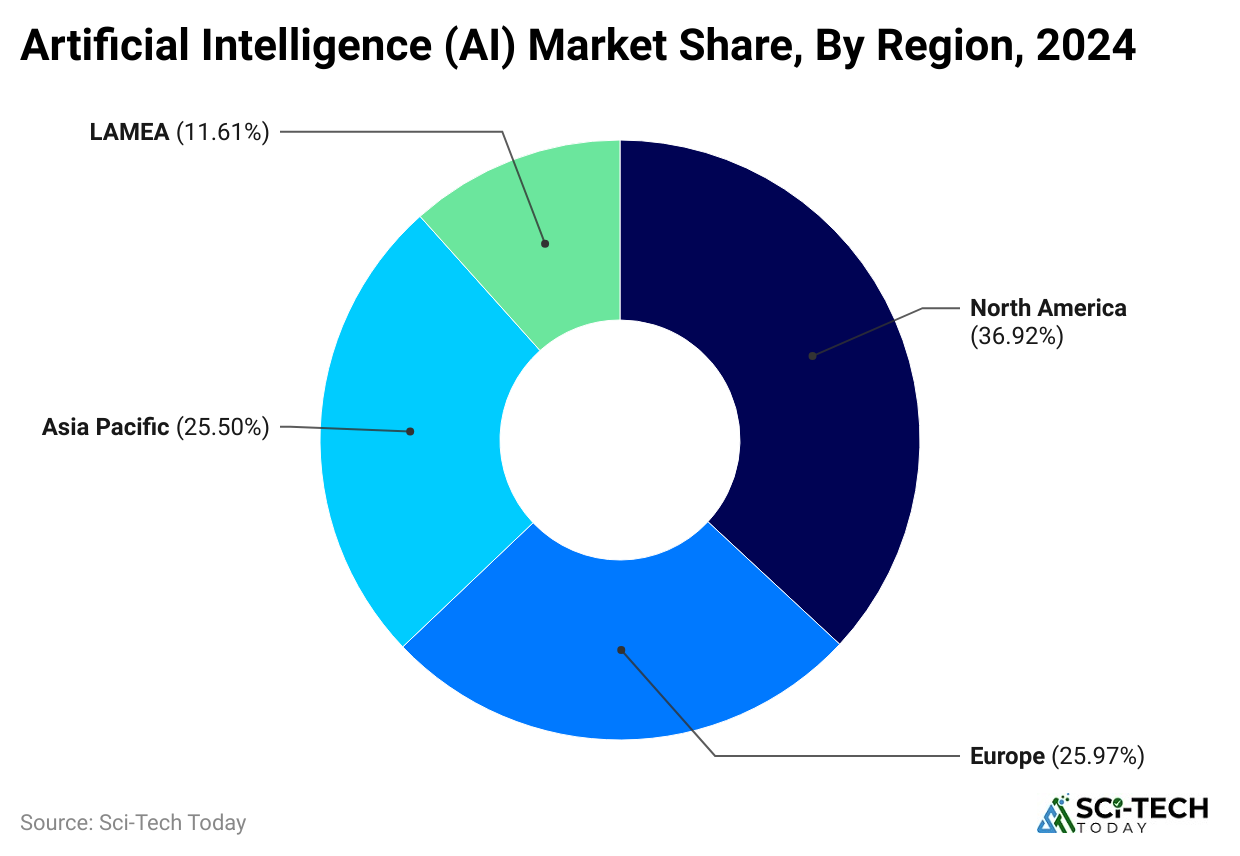
- The above pie chart states that in 2024, the North American region accounted for the highest market of Artificial Intelligence with a share of 36.92%.
- Moreover, other regions’ AI market shares are followed by Europe (25.97%), Asia Pacific (25.50%), and LAMEA (11.61%).
The table below represents the regional revenue analysis of Artificial Intelligence in 2024
| Region | Revenue (USD) | CAGR (2024 to 2030) |
| Asia | 66.03 billion | 28.58% |
| Americas | 63.90 billion | 28.34% |
| Europe | 46.67 billion | 28.44% |
| Central & Western Europe | 28.16 billion | 28.40% |
| Australia & Oceania | 3.74 billion | 28.52% |
| Africa | 3.70 billion | 28.34% |
| Caribbean | 218.90 million | 28.56% |
By Digital Assistants
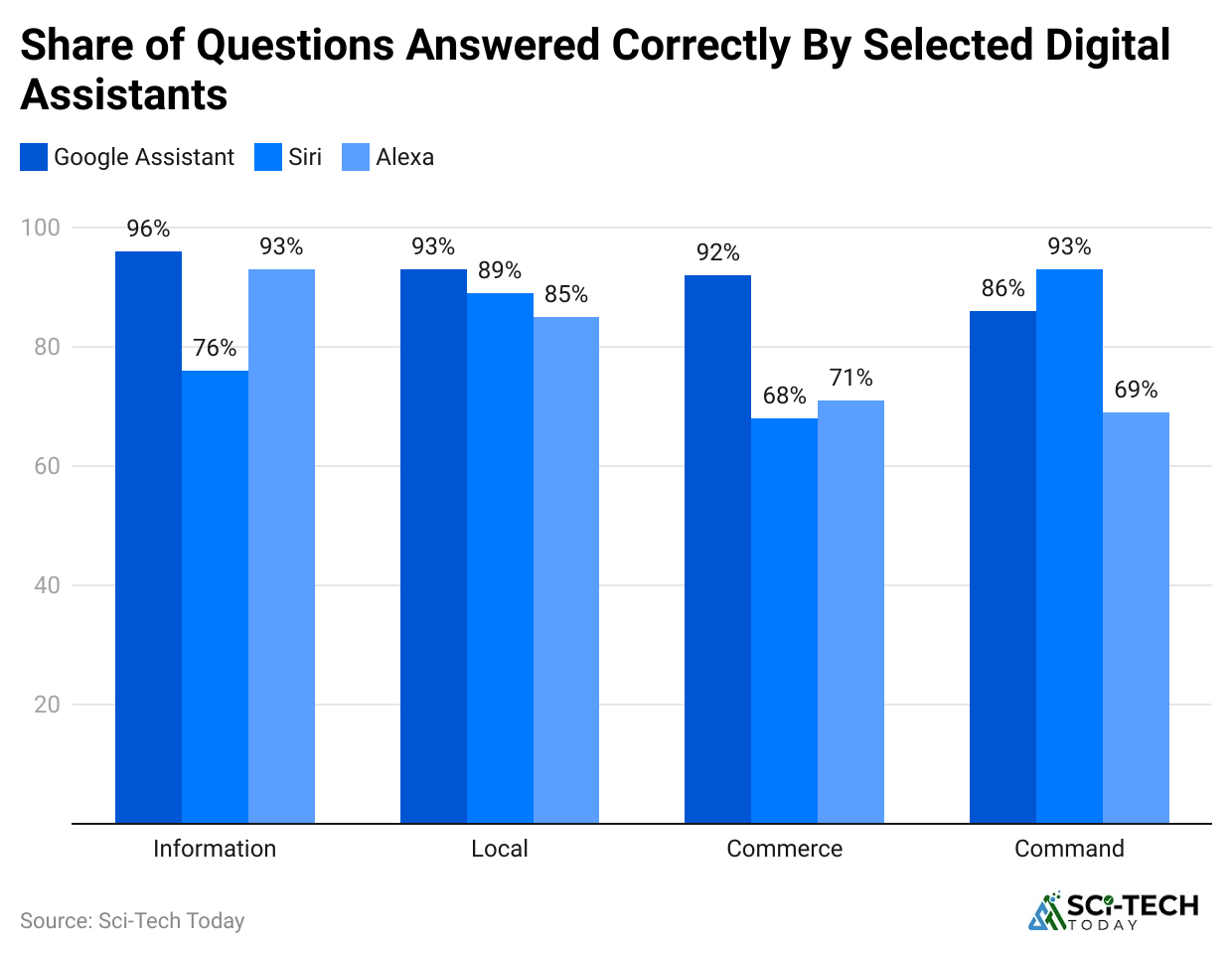
- As of 2024, the share of finding out information correctly, Google Assistant secured the highest accuracy rate of 96%, followed by Alexa (93%), and Siri (76%).
In 2024, the table below shows how many questions were correctly answered by different digital assistants:
| Type of question | Google Assistant | Alexa | Siri |
| Local | 93% | 85% | 89% |
| Commerce | 92% | 71% | 68% |
| Command | 86% | 69% | 93% |
Artificial Intelligence Technology Statistics
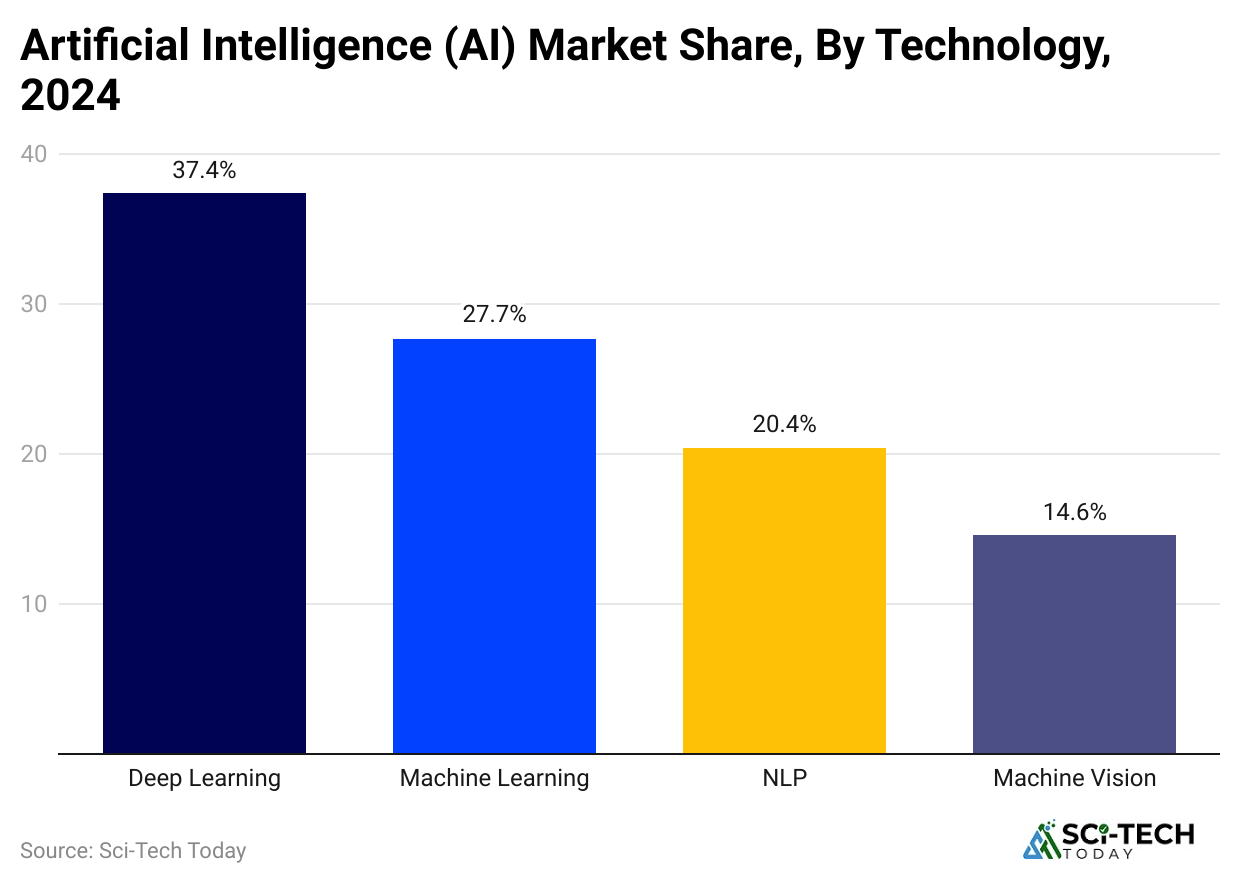
- As of 2024, the market share of deep learning secured a share of 37.4% followed by machine learning (27.7%), NLP (20.4%), and machine vision (14.6%).
Meanwhile, the market revenue of AI statistics by technology is stated in the table below:
| Technology | 2023 (USD billion) | 2024 (USD billion) |
| Deep Learning | 196.83 | 233.69 |
| Machine Learning | 145.43 | 172.72 |
| NLP | 108.31 | 128.50 |
| Machine Vision | 87.57 | 103.33 |
Artificial Intelligence Solution Statistics
- Precedence Research report analysis states that in 2024, the services segment of AI accounted for the highest share of 39.2%.
- Whereas, the Software and hardware segments followed with a share of 37% and 23.8%, respectively.
- As of 2024, the AI solution segment’s market revenue is stated as Service (USD 246.14 billion), Software (USD 237.86 billion), and Hardware (USD 154.22 billion).
Global Artificial Intelligence Market Revenue Statistics By Industry in 2024
| Industry | AI Revenue (USD Billion) |
| BFSI | 102.26 |
| Healthcare | 90.48 |
| Advertising & Media | 88.96 |
| Automotive & Transportation | 63.87 |
| Retail | 62.06 |
| Manufacturing | 61.49 |
| Agriculture | 41.39 |
| Law | 22.67 |
| Others | 105.04 |
Artificial Intelligence Software Revenue Statistics
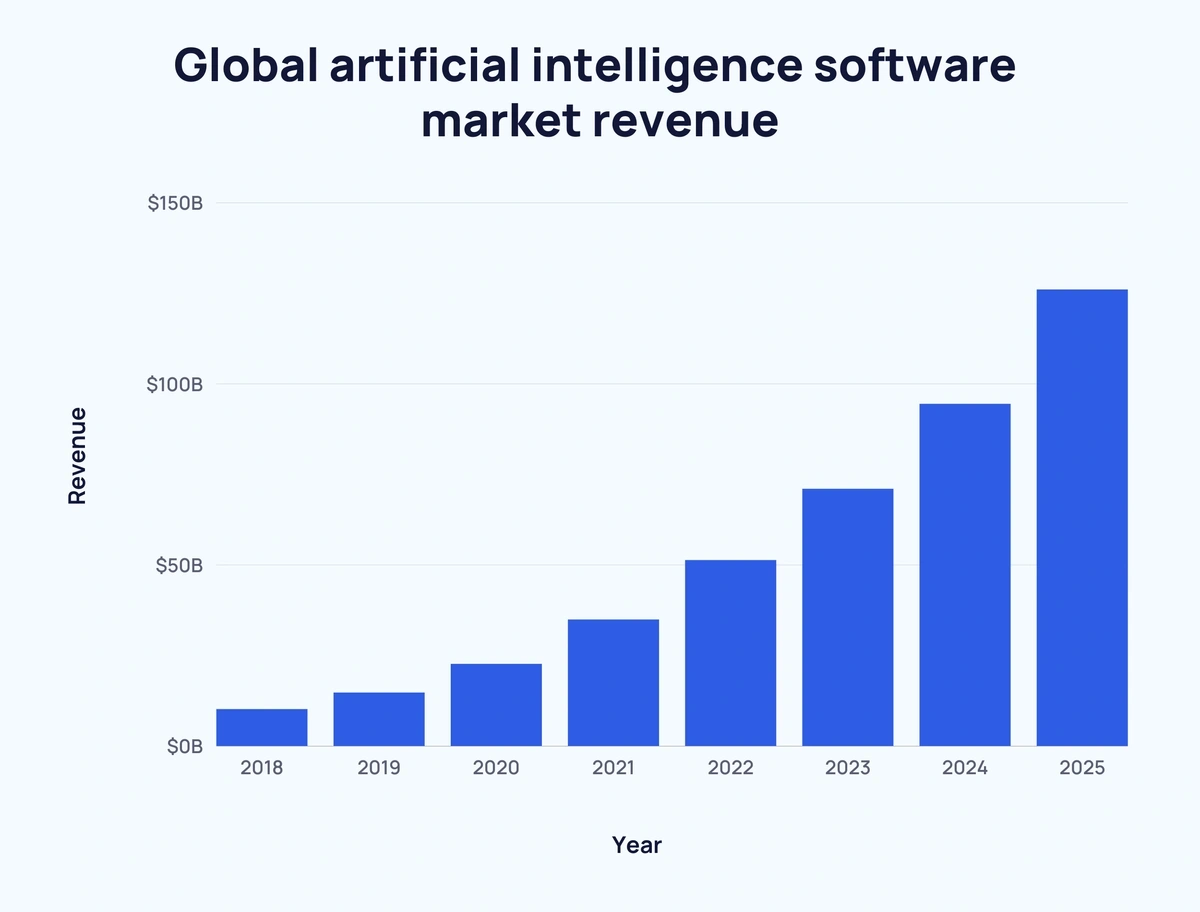
- The above graph shows that by the end of 2025, the global market revenue of artificial intelligence software is expected to reach USD 126 billion.
- The valuation has grown from the previous year, such as 2024 (USD 94.41 billion), 2023 (USD 70.94 billion), and 2022 (USD 51.27 billion).
Generative Artificial Intelligence Market Size Statistics
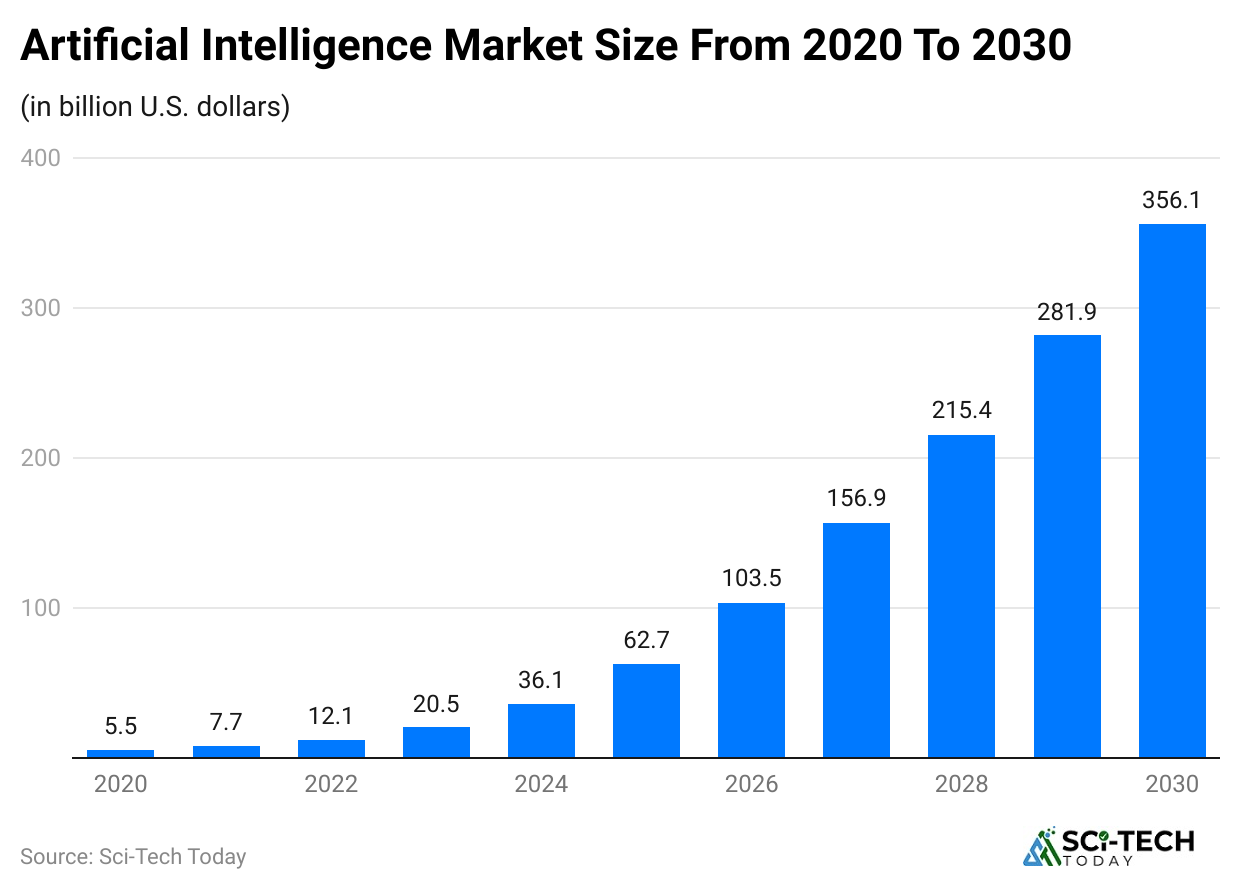
- The Generative AI market will reach USD 66.89 billion in 2025.
- The annual growth of the market will grow at a CAGR of 36.99% from 2025 to 2031.
- By the end of 2031, the market size is forecasted to hit USD 442.07 billion.
- It is estimated to reach around USD 103.50 billion by 2026, followed by USD 156.90 billion (2027), USD 215.40 billion (2028), USD 281.90 billion (2029), and USD 356.10 billion (2030).
- The United States will hold the largest share, resulting in USD 21.65 billion by 2025.
Artificial Intelligence Uses Statistics
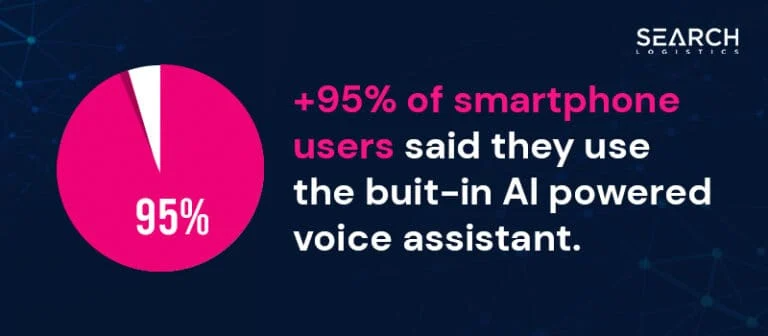
- Over 95% of smartphone users said they use the built-in AI-powered voice assistant.
- As of 2024, the number has doubled, with 8.4+ billion devices powered by AI assistants.
Companies’ market share of AI voice assistants is stated in the table below:
| Company | AI Market Share |
| Apple (Siri) | 36% |
| Google (Google Assistant) | 36% |
| Microsoft (Cortana) | 26% |
| Amazon (Alexa) | 19% |
Smart speaker AI companies’ market shares are stated below:
| Company | AI Market Share |
| Amazon | 28.9% |
| 19.1% | |
| Baidu | 13.1% |
| Alibaba | 12.7% |
| Apple | 5.9% |
| Other | 20.5% |
By Workplace and Personal Use
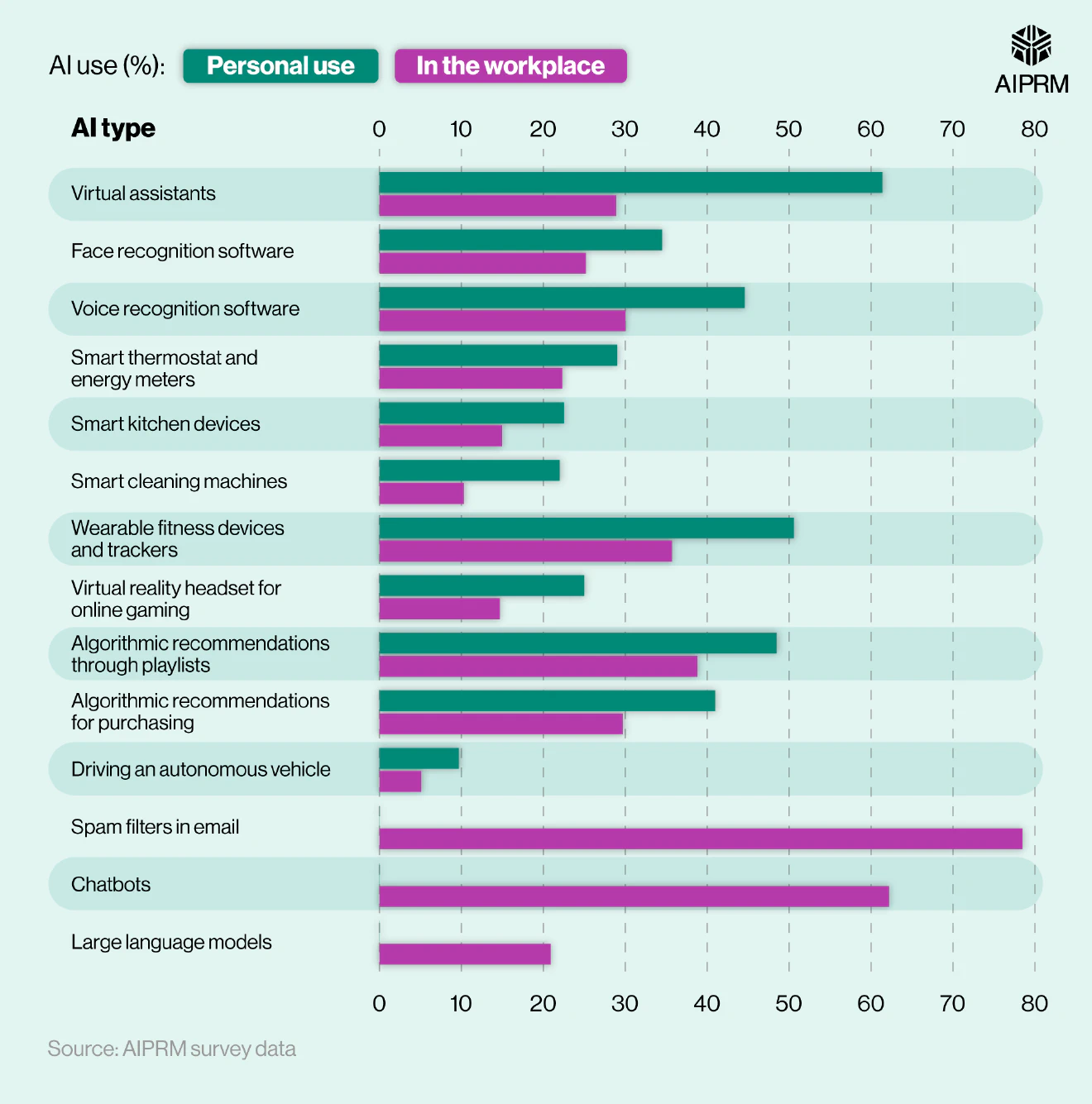
- The most common spam filter is used within emails; nearly 79% of workers said they use this in 2024
- The next most popular use is chatbots that help answer customer service questions, used by about 62% of employees.
- About 61% of people said they use AI assistants like Alexa or Siri, but mostly outside of work, while at the workplace, only 29% said they use these virtual assistants.
- Fitness trackers and smartwatches are also more popular outside of work, with over 50% using them personally, while only 36% use them at work.
- A similar trend is seen with music and video recommendations: about 49% use them outside work, while 39% use them on the job.
- A Forbes consumer survey also showed that many people plan to use AI to reply to messages (45%) or to get help with financial questions (43%).
By Consumers
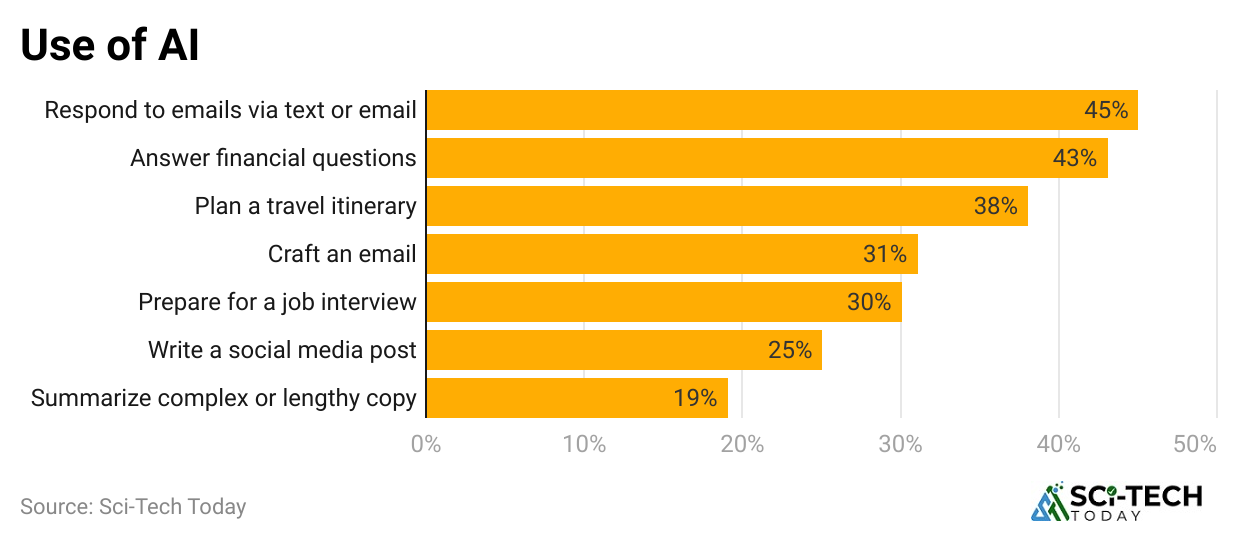
- The aiprm.com website states that 45% of people used AI for responding to emails via text, followed by 43% to answer financial questions.
- Other common uses of AI by consumers include planning a travel itinerary (38%), crafting an email (31%), preparing for a job interview (30%), writing a social media post (25%), and summarising complex or lengthy copy (19%).
- According to AI statistics, 70% of people believe generative AI brings more good than harm, while 65% trust companies that use modern AI tools.
- However, 48% feel AI isn’t properly regulated, while only 31% think current rules are enough.
- One in three say AI improves work productivity, especially in India (67%) and Indonesia (65%), unlike Sweden (14%) or the U.S. (17%).
- Over 60% worry about scams, fake news, and cyber threats.
- Also, 77% fear job loss, and 65% prefer ChatGPT to search engines.
Artificial Intelligence Demographic Statistics by Age Group
- Among those aged 61 and older, about 30.8% use Virtual assistants like Siri and Alexa every week.
- Around 14% of people between 41 and 60 years old rely on virtual helpers weekly.
- Only 25.3% of people aged between 26 and 40 years use them regularly.
- And nearly 29.9% of individuals aged 18 to 25 also use voice assistants often.
- However, over 80% of young adults between 18 and 25 have never interacted with a large language model.
- Gen X and Baby Boomers make up 68% of people who have never used this kind of AI.
By Gender
| Category | Men | Women |
| Awareness of AI | 38% | 23% |
| Daily Spam Filter Usage | 29.7% | 29.2% |
| Never Driven an Autonomous Vehicle | 84.7% | 85.6% |
| Never Used Large Language Models | 78.9% | 79.4% |
| Never Used Smart Cleaning Machines | 67.5% | 67.9% |
| Virtual Assistant Use | Higher | Lower |
| Weekly Playlist Recommendations Use | Lower | Higher |
| Monthly AI Tech Use (e.g., fitness trackers) | Lower | Higher |
Artificial Intelligence in Businesses Statistics
- A report published by hai.stanford.edu stated that in 2024, 78% of organisations were using AI in at least one business function.
- In 2024, the U.S. invested the most in AI privately, spending USD 109.1 billion.
- China followed with USD 9.3 billion, and the UK with USD 4.5 billion.
- 82% of companies employ AI mainly in marketing, with 31% in customer support operations, according to the reports of arxiv.org.
- Besides, for managing big data, AI is used by 48% of businesses.
- As reported by Synthesia, over 90% of top service providers now use AI throughout their talent processes.
- Adoption rates differ across roles: 52% of engineers use AI, followed by 49% of executives, 40% of professionals, and 38% of middle managers.
- In the field of competitive intelligence, 25% of leaders use AI, and another 56% are planning to adopt it.
- In 2024, the most common business uses of AI include content creation (55%), SEO data analysis (54%), image generation (53%), video production (52%), and audio generation (22%).
- In contrast, 58% of marketers aimed to increase their investment in AI tools like chatbots.
- About 60% view AI as a helpful assistant, while 16% think it could handle most of their work.
- Marketers rely on AI for idea generation (45%), creating outlines (31%), drafting (18%), and writing content (6%).
- One in three companies plans to use ChatGPT for website content.
- AI is also used by 46% of business owners for internal messaging.
- Companies report better SEO (65%), improved ROI (68%), and high content rankings (76%) after adopting AI.
Artificial Intelligence in Marketing Statistics
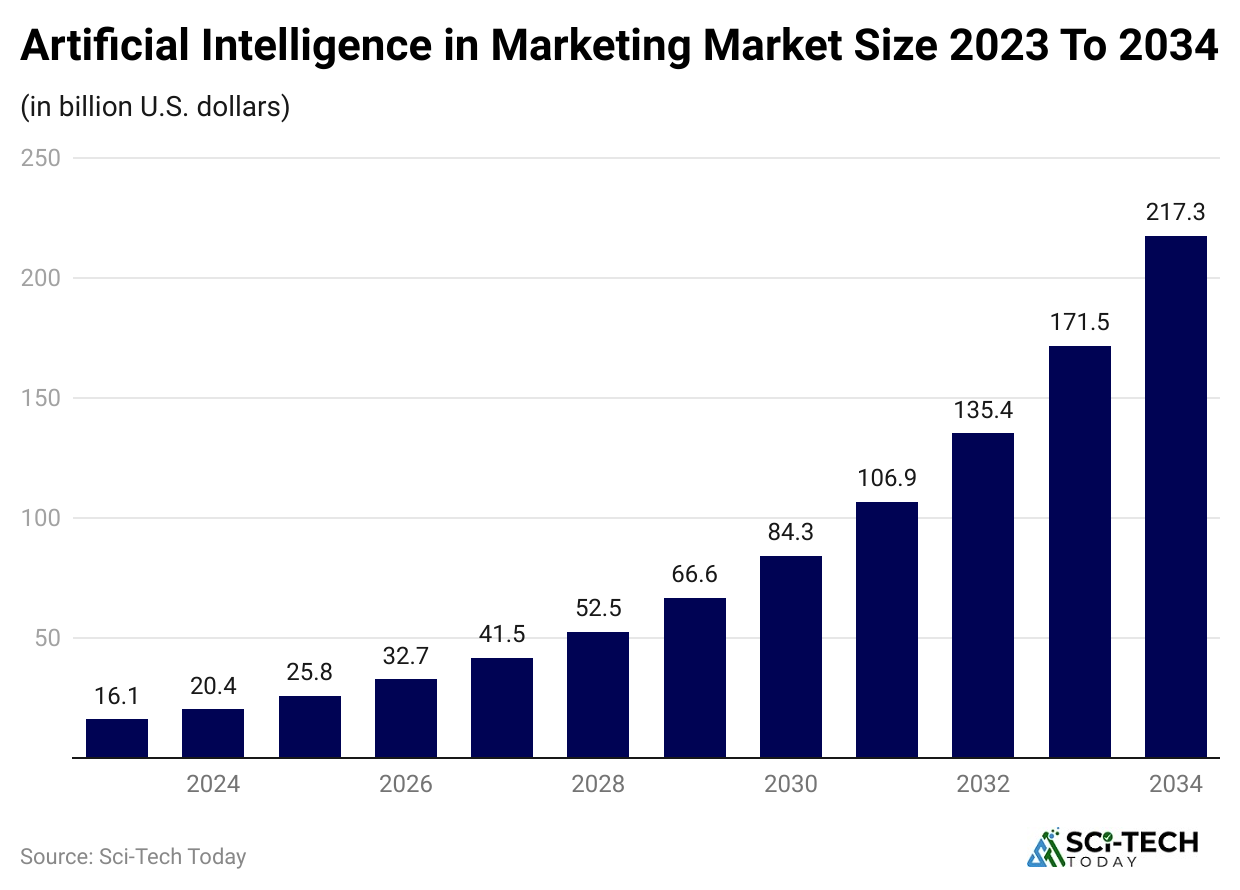
- The above graph estimates that by the end of 2025, the ‘AI in marketing’ market is expected to reach around 25.83 billion 2025.
- It is estimated that by the end of 2034, the market will make up USD 217.33 billion, with a CAGR of 26.7% from 2023 to 2034.
- The reports of Digital Market Insights show that 51% of marketers use AI to improve email and SEO content, while 50% use it to help create content.
- Besides, other marketers use AI for brainstorming (45%), automation (43%), data analysis (41%), social media (43%), personalizing customer experiences (73%), inspiration (45%), creating outlines (31%), drafting content (18%), and writing full content (6%).
- After using AI tools, marketers now save about 3 hours on each content piece and 2.5 hours every day.
- Around 85% believe generative AI will reshape content creation in 2024.
- Still, 60% are concerned about bias or plagiarism hurting their brand.
- In recent years, many companies report better SEO (65%) and improved ROI (68%), as 76% say AI content ranks well.
Artificial Intelligence Job Market Statistics
- According to Forbes, 56% of companies use AI for customer service, while 51% apply it in cybersecurity and fraud prevention.
- Around 47% use digital assistants, 46% manage customer relationships with AI, and 40% rely on it for inventory tracking.
- As of 2024, experts say automation may both replace and create jobs (52%).
- AI could boost labour productivity by 1.5% in the next decade. Globally, AI-led growth may be 25% higher than automation without it.
- Productivity is expected to improve by 40%, and 60% of business owners agree.
- In 2023, data engineers had 1,898 job openings, followed by 1,692 for data scientists.
Artificial Intelligence Training Statistics
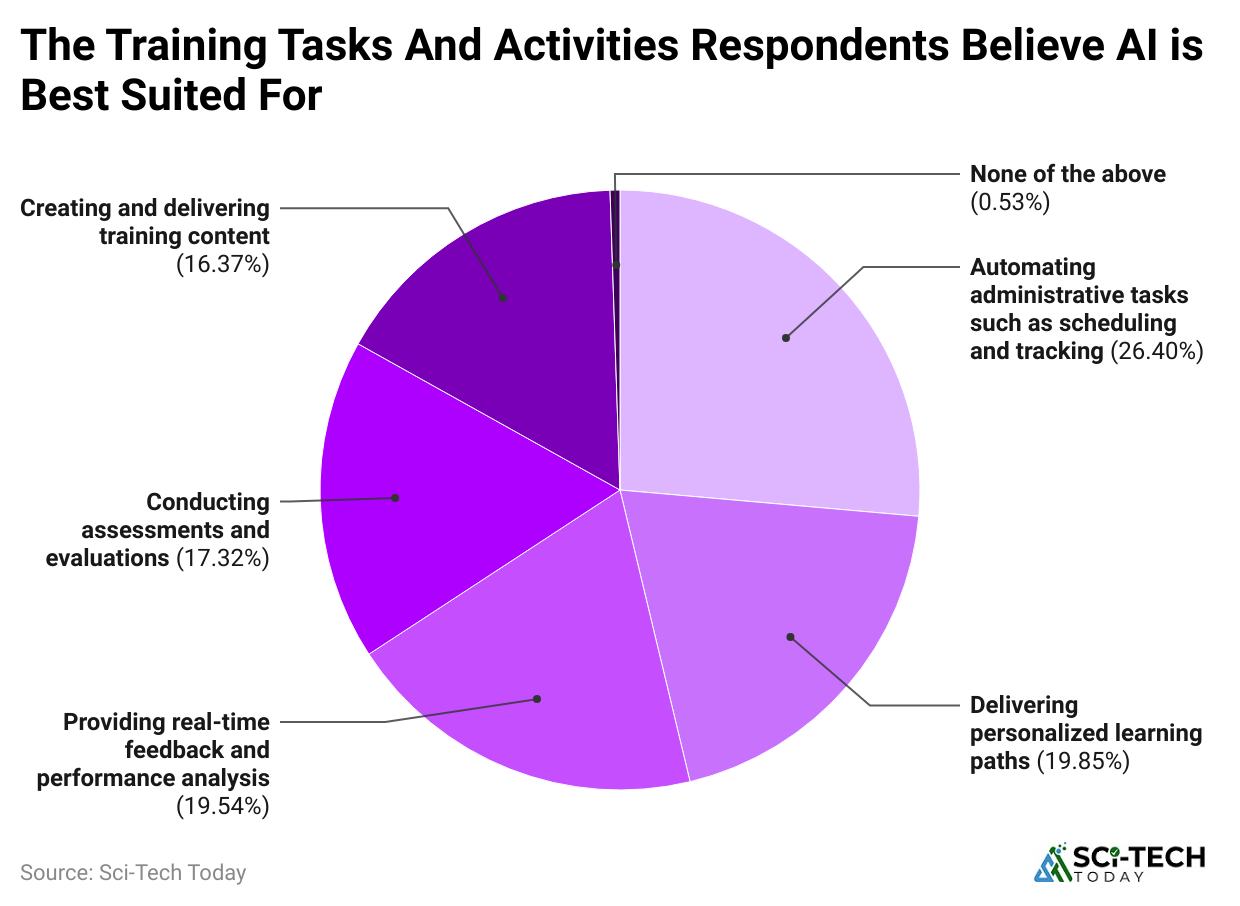
- As of 2024, the above survey showed that 26.40% of people believe AI is most useful for automating admin work like scheduling and tracking.
- Meanwhile, 19.85% claimed AI helped in giving learners personalised learning paths.
- Around 19.54% saw value in AI giving real-time feedback and checking performance.
- 32% think it’s good for tests and evaluations, while 16.37% said it’s useful in making and sharing training content.
- Only 0.53% saw no benefit in AI for training.
academyocean.com reports further states different challenges faced in employee training after the increased use of AI:
| Top AI Challenges | Concern Share |
| Data privacy and security | 21.32% |
| Lack of human interactions | 19.57% |
| Resistance to change and skill gaps | 16.57% |
| Technical limitations and errors | 15.31% |
| Bias and fairness | 13.28% |
| Ethical considerations | 13.08% |
Salaries for AI Professionals Statistics
| Professionals | 0-1 year (USD) | 1-3 years (USD) | 4-6 years (USD) | 7-9 years (USD) | 10-14 years (USD) |
| AI engineer | 100,324 | 104,196 | 115,053 | 123,989 | 132,496 |
| AI researcher | 88,713 | 99,467 | 112,453 | 121,630 | 134,231 |
| Machine learning engineer | 105,418 | 114,027 | 120,368 | 127,977 | 135,388 |
| Robotics engineer | 76,453 | 76,453 | 92,791 | 97,121 | 108,230 |
| Software engineer | 94,940 | 99,370 | 105,114 | 112,808 | 126,369 |
| Data scientist | 107,150 | 107,150 | 116,717 | 125,259 | 134,922 |
Addressable Artificial Intelligence Statistics by Scenario
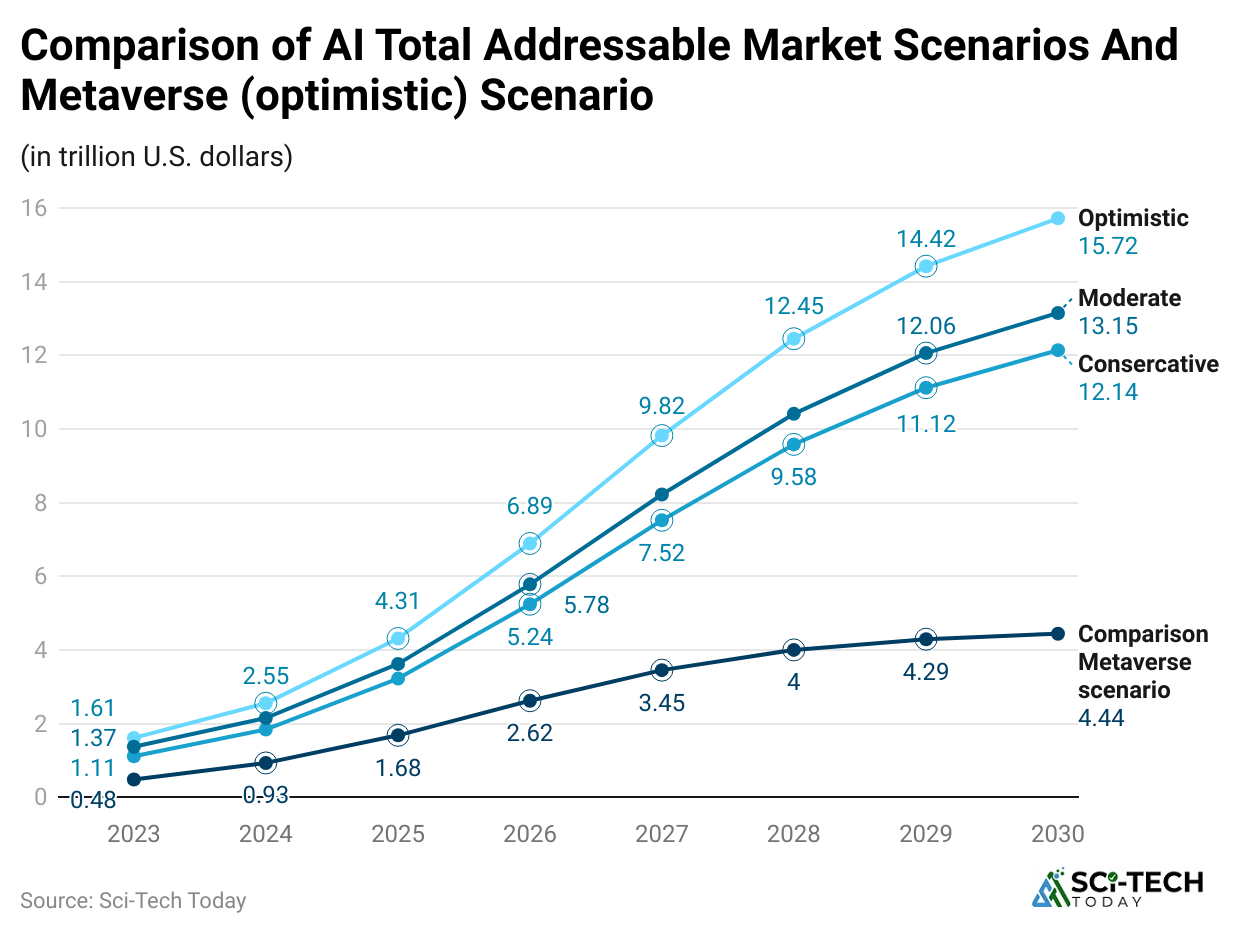
- Artificial Intelligence Statistics further depicts that by 2025, the largest market size of Artificial Intelligence will be secured by an optimistic scenario, resulting in USD 4.31 trillion, with a GDP growth rate of 92%.
- Followed by a moderate scenario (USD 3.62 trillion) (3.29%) and a conservative scenario (USD 3.22 trillion) (92%).
Overall addressable AI market size and GDP growth rate by other scenarios in the coming few years are stated below:
| Year | Optimistic (USD trillion) | Moderate (USD trillion) | Conservative (USD trillion) |
| 2026 | 6.89 (5.96%) | 5.78 (4.99%) | 5.24 (4.53%) |
| 2027 | 9.82 (8.09%) | 8.22 (6.78%) | 7.52 (6.20%) |
| 2028 | 12.45 (9.78%) | 10.41 (8.19%) | 9.58 (7.53%) |
| 2029 | 14.42 (10.88%) | 12.06 (9.10%) | 11.12 (8.39%) |
| 2030 | 15.72 (11.41%) | 13.15 (9.54%) | 12.14 (8.81%) |
Artificial Intelligence Impact on the Demand Statistics by Skills
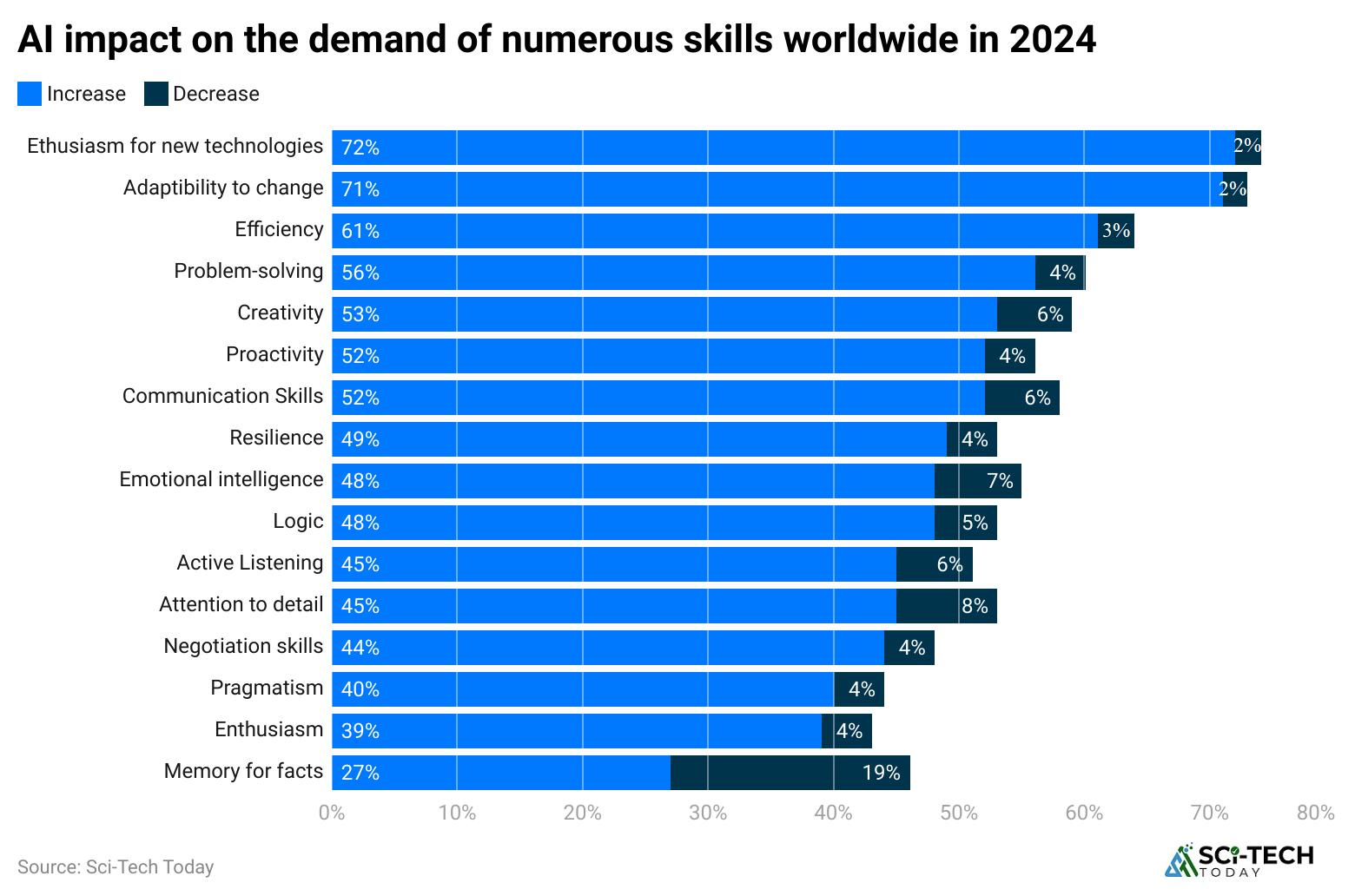
- As of 2024, almost 72% of professionals think AI adaptability will change, but 2% expect a drop, followed by efficiency: 61% (increase) and 3% (decrease); problem-solving: 56% (increase) and 4% (decrease).
Other skills and their impact on the AI demand are discussed below:
| Skills | Increase | Decrease |
| Creativity | 53% | 6% |
| Proactivity | 52% | 4% |
| Communication skills | 52% | 6% |
| Resilience | 49% | 4% |
| Emotional Intelligence | 48% | 7% |
| Logic | 48% | 7% |
| Active Listening | 48% | 7% |
| Attention to detail | 45% | 6% |
| Negotiation skills | 44% | 4% |
| Pragmatism | 40% | 4% |
| Enthusiasm | 39% | 4% |
| Memory for facts | 27% | 19% |
Companies Investing in Artificial Intelligence Statistics
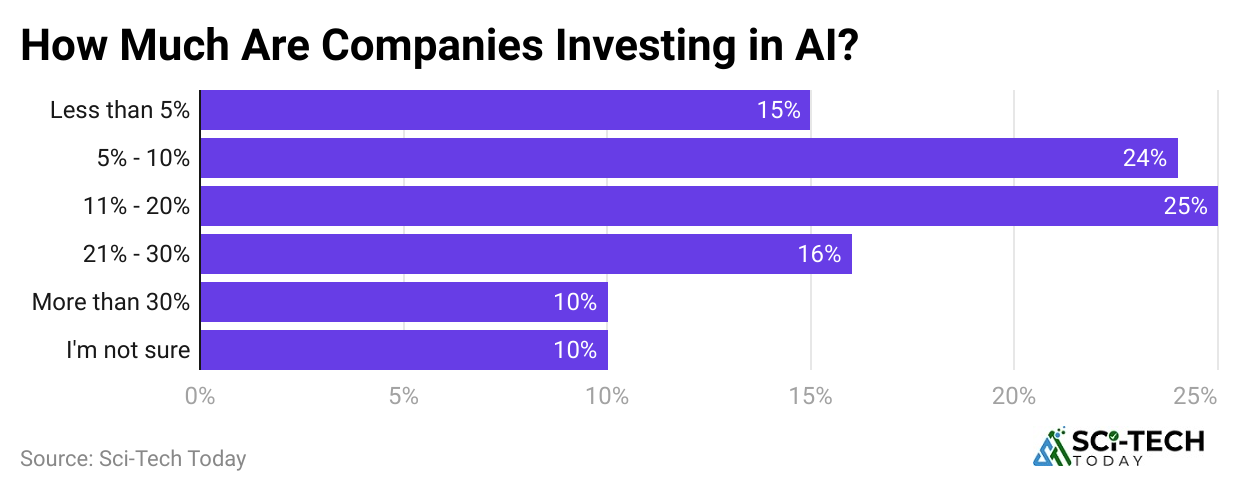
- By October 2024, nearly 49% of companies spent 5% to 20% of their tech budgets on AI-related projects.
- In which 25% of companies spend around 11% to 20% their budget on AI, and 24% of companies (5% to 10% budget on AI).
| Companies Share | AI Budget Share |
| 16% | 21% to 30% |
| 15% | Less than 5% |
| 10% | More than 30% |
| 10% | Not Sure |
Company’s Artificial Intelligence Tool Adoption Statistics
- A report published by Hostinger states that around 30% of business leaders reported early or AI adoption in 2024, followed by a moderate stage of adoption (26% of businesses).
- In the same period, total businesses shared by state of AI tool adoption are followed by advanced adoption (14%), full integration (6%), and no adoption (24%).
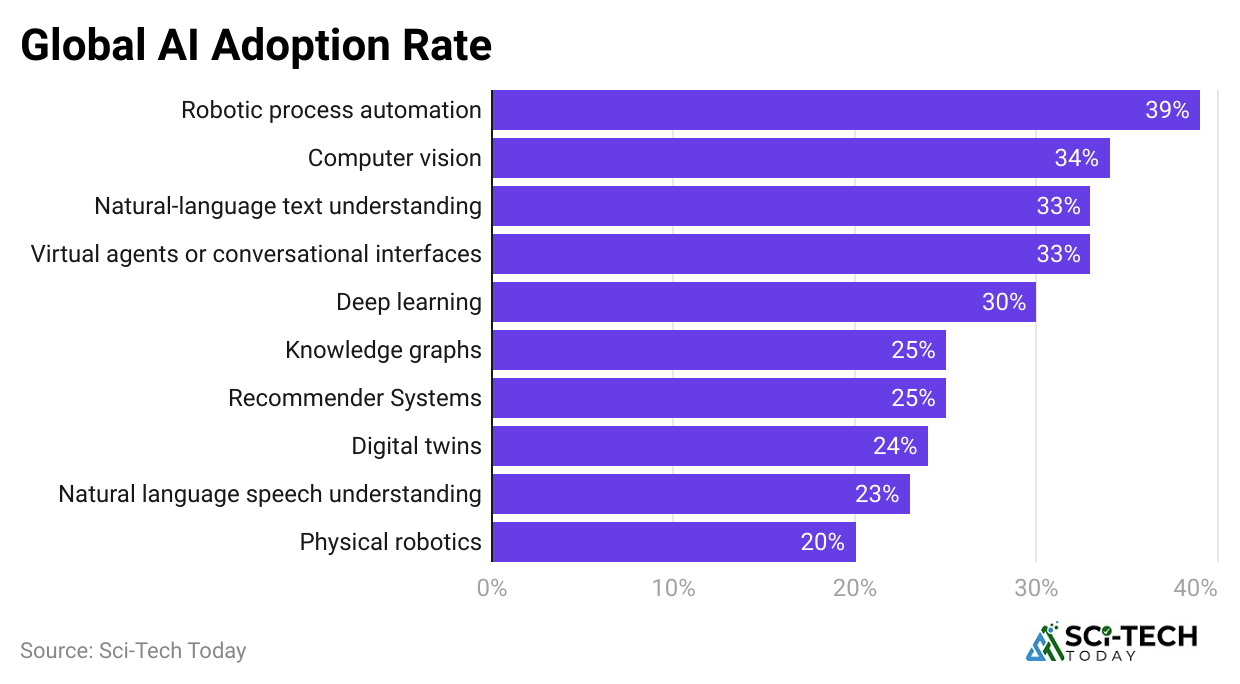
- The adoption rate of robotic process automation remained around 39%, followed by computer vision (34%) and natural-language text understanding (33%).
- Globally, other AI adoption rates are followed by virtual agents or conversational interfaces (33%), deep learning (30%), knowledge graphs (25%), recommender systems (25%), digital twins (24%), natural language speech understanding (23%), and Physical robotics (20%).
AI implementation advancements shared in companies are mentioned in the table below:
| Upskilling and reskilling employees to adapt to AI integration | 37% |
| Automation routine tasks to increase employee focus on strategic work | 36% |
| Redefining job roles/responsibilities to align with AI integration | 31% |
| Hiring new talent with AI expertise | 31% |
| Expanding cross-functional collaboration between AI teams and other departments | 26% |
| Minimising workforce reduction by reallocating employees to new roles | 19% |
| Others | 7% |
Benefits of Artificial Intelligence Statistics
- A report published by AIPRM shows that about 43.1% of people in our survey think AI will help them work faster, while 39.4% feel it will also improve how they make decisions.
- Furthermore, potential benefits by respondents shares are followed by reducing the risk of errors (35.3%), reduce response time (34%), streamline job processes (30.9%), improve customer relationships (30.8%), save costs (25.3%), increase sales (19.6%), and none of the above (4.1%).
Challenges of Investing In Artificial Intelligence Statistics

- In recent years, around 56% of companies, when trying to use AI, claimed that their employees don’t have the necessary skills.
- Around 42% are unsure about what AI might bring in the future.
- In contrast, only 26% don’t even know the right areas where they should invest their money.
Recent Developments of Artificial Intelligence Statistics
| Date | Developments |
| February 2025 | ● OpenAI introduced a new AI feature named Deep Research to help users explore topics better. |
| May 2025 | ● Union Minister Jitendra Singh suggested using AI to help assign IAS officers to specific roles.
● Tripura’s Chief Minister Manik Saha shared plans to build infrastructure supporting AI and 5G. |
| December 2024, |
● Google launched Gemini 2.0, a smarter AI that can do more human-like tasks. ● Puma made an AI for better designs. |
| September 2024 |
● The EU has started a plan to set up AI factories to boost AI development. ● Bharti Airtel uses AI in its network to stop spam calls. |
Artificial Intelligence Gross Value Added Statistics by Industry in 2035
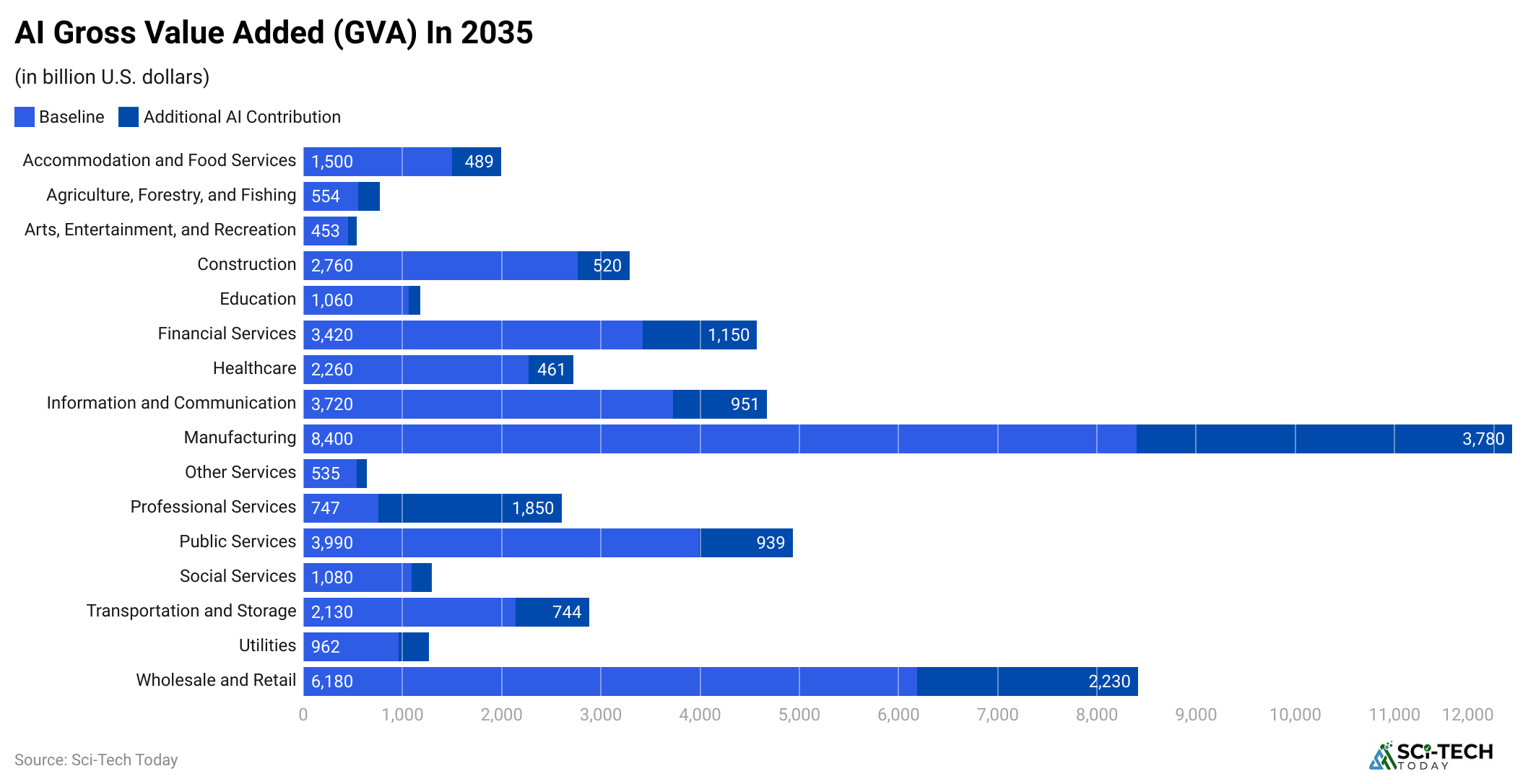
| Industry | Baseline (USD) | Additional AI Contribution (USD) |
| Manufacturing | 8.4 trillion | 3.78 trillion |
| Professional Services | 7.47 trillion | 1.85 trillion |
| Wholesale and Retail | 6.18 trillion | 2.23 trillion |
| Public Services | 3.99 trillion | 939 billion |
| Information and Communication | 3.72 trillion | 951 billion |
| Financial Services | 3.42 trillion | 1.15 trillion |
| Construction | 2.76 trillion | 520 billion |
| Healthcare | 2.26 trillion | 461 billion |
| Transportation and Storage | 2.13 trillion | 744 billion |
| Accommodation and Food Services | 1.5 trillion | 489 billion |
| Social Services | 1.08 trillion | 216 billion |
| Education | 1.06 trillion | 109 billion |
| Utilities | 962 billion | 304 billion |
| Agriculture, Forestry, and Fishing | 554 billion | 215 billion |
| Arts, Entertainment, and Recreation | 453 billion | 87 billion |
| Other Services | 535 billion | 95 billion |
Conclusion
After completing the article on Artificial Intelligence Statistics, it can be concluded that AI is now used in every core part of businesses, governments, and individuals’ daily lives. AI has quickly become a big part of industries around the world. It helps in making smart decisions, improving customer service, and handling complex tasks automatically.
In recent years, this technology has become easier to use and more available to businesses of all sizes. As AI keeps growing, it’s clear that its impact will become even stronger in the future. But with this progress, it’s also important to use AI in a fair and responsible way, follow proper rules, and keep improving it so that everyone can benefit. The future of AI is promising, but it must be approached responsibly.
Sources
FAQ.
- Narrow AI: Performs specific tasks (e.g., Siri, Google Maps).
- General AI: Human-level intelligence across tasks (still under development).
- Super AI: Surpasses human intelligence (theoretical for now).
AI is safe if used responsibly, but misuse can lead to privacy and bias issues.
The best artificial Intelligence for language is ChatGPT, for driving (Tesla Autopilot), and for healthcare (IBM Watson).
The benefits of AI are automating tasks, improving customer service, analysing data, reducing costs, and making smarter decisions.
Yes, AI is safe if used carefully, but risks like bias and privacy issues still exist.

Maitrayee, after completing her graduation in Electrical Engineering, transitioned into the world of writing following a series of technical roles. She specializes in technology and Artificial Intelligence, bringing her experience as an Academic Research Analyst and Freelance Writer, with a focus on education and healthcare under the Australian system. From an early age, writing and painting have been her passions, leading her to pursue a full-time career in writing. In addition to her professional endeavors, Maitrayee also manages a YouTube channel dedicated to cooking.
